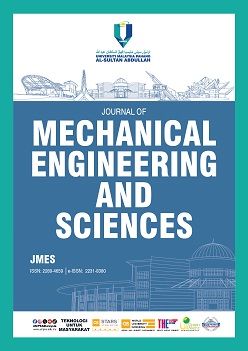Indoor positioning system for warehouse environment: A scoping review
DOI:
https://doi.org/10.15282/jmes.18.4.2024.9.0815Keywords:
Indoor positioning system, Indoor localization, Positioning technology , Warehouse environment, Inventory management, Environmental sustainabilityAbstract
Advanced technologies and automation, driven by Indoor Positioning Systems (IPS), are transforming businesses by enhancing efficiency, intelligence, and digitalization. Despite the critical role of IPS, there remains a lack of comprehensive reviews focusing specifically on their applications in warehouse inventory management. To bridge this gap and provide actionable insights for both research and practical implementation, this study conducts a systematic literature review following the PRISMA checklist. Centered around three key research questions, this review explores the scope of IPS applications in warehouse environments, the specific technologies employed, and the methods to evaluate IPS performance. This paper analyzes the fundamental principles and recent applications of widely adopted indoor positioning technologies, including Wi-Fi, UWB, RFID, VLC, IMU, Computer Vision, and LiDAR. Furthermore, this paper evaluates IPS technologies through five key evaluation criteria, highlighting their advantages, limitations, and challenges. This study provides a comprehensive understanding of IPS technologies in warehouse inventory management, offering actionable methods to evaluate their performance. The insights presented aim to deliver strong decision support for researchers and practitioners seeking to optimize inventory operations in warehouse environments.
References
[1] S. Zimmermann, R. Poranne, S. Coros, “Go fetch! - Dynamic grasps using Boston Dynamics Spot with external robotic arm,” in IEEE International Conference on Robotics and Automation (ICRA), vol. 1, pp. 4488–4494, 2021.
[2] M. Javaid, A. Haleem, R. P. Singh, R. Suman, “Substantial capabilities of robotics in enhancing industry 4.0 implementation,” Cognitive Robotics, vol. 1, pp. 58–75, 2021.
[3] The New York Times, “Robots aren’t done reshaping warehouses,” New York, USA [Online], 2023. Available: www.nytimes.com
[4] J. M. Davila Delgado, L. Oyedele, A. Ajayi, L. Akanbi, O. Akinade, M. Bilal, et al., “Robotics and automated systems in construction: Understanding industry-specific challenges for adoption,” Journal of Building Engineering, vol. 26, p. 100868, 2019.
[5] J. Holland, L. Kingston, C. McCarthy, E. Armstrong, P. O’Dwyer, F. Merz, et al., “Service robots in the healthcare sector,” Robotics, vol. 10, no. 1, pp. 1–47, 2021.
[6] G. Yang, Z. Pang, M. J. Deen, M. Dong, Y. Zhang, N. Lovell, et al., “Homecare robotic systems for healthcare 4.0: visions and enabling technologies,” IEEE Journal of Biomedical and Health Informatics, vol. 24, no. 9, pp. 2535–2549, 2020.
[7] N. Li, L. Guan, Y. Gao, S. Du, M. Wu, X. Guang, et al., “Indoor and outdoor low-cost seamless integrated navigation system based on the integration of INS/GNSS/LIDAR system,” Remote Sensing, vol. 12, no. 19, p. 3271, 2020.
[8] E. D. Kaplan, C. Hegarty. Understanding GPS/GNSS: Principles and Applications. 3rd Eds. United States: Artech House, 2017.
[9] X. Zhu, W. Qu, T. Qiu, L. Zhao, M. Atiquzzaman, D. O. Wu, “Indoor intelligent fingerprint-based localization: principles, approaches and challenges,” IEEE Communications Surveys & Tutorials, vol. 22, no. 4, pp. 2634–2657, 2020.
[10] L. Zhen, H. Li, “A literature review of smart warehouse operations management,” Frontiers of Engineering Management, vol. 9, no. 1, pp. 31–55, 2022.
[11] T. M. Fernández-Caramés, O. Blanco-Novoa, I. Froiz-Míguez, P. Fraga-Lamas, “Towards an autonomous industry 4.0 warehouse: A UAV and blockchain-based system for inventory and traceability applications in big data-driven supply chain management,” Sensors, vol. 19, no. 10, p. 2394, 2019.
[12] S. Janasekaran, S. Mann, “A case study: implementation of automated guided vehicle replacing trollies transportation in manufacturing industry to reduce motion waste in lean manufacturing practicing factory,” Journal of Engineering & Technological Advances, vol. 5, no. 1, pp. 1–7, 2020.
[13] I. Kalinov, A. Petrovsky, V. Ilin, E. Pristanskiy, M. Kurenkov, V. Ramzhaev, “WareVision: CNN barcode detection-based UAV trajectory optimization for autonomous warehouse stocktaking,” IEEE Robotics and Automation Letters, vol. 5, no. 4, pp. 6647–6653, 2020.
[14] P. Octaviani, W. Ce, “Inventory placement mapping using bluetooth low energy beacon technology for warehouses,” in International Conference on Information Management and Technology (ICIMTech), vol. 1, pp. 354–359, 2020.
[15] M. Beul, N. Krombach, M. Nieuwenhuisen, D. Droeschel, S. Behnke, “Autonomous navigation in a warehouse with a cognitive micro aerial vehicle,” in Robot Operating System (ROS): The Complete Reference, vol. 2, pp. 487–524, 2017.
[16] H. Arksey, L. O’Malley, “Scoping studies: towards a methodological framework,” International Journal of Social Research Methodology, vol. 8, no. 1, pp. 19–32, 2005.
[17] A. C. Tricco, E. Lillie, W. Zarin, K. O'Brien, H. Colquhoun, D. Levac, et al., “PRISMA extension for scoping reviews (PRISMA-ScR): Checklist and explanation,” Annals of Internal Medicine, vol. 169, no. 7, pp. 467–473, 2018.
[18] A. Liberati, D. G. Altman, J. Tetzlaff, C. Mulrow, P. C. Gøtzsche, P. J. Devereaux, et al., “The PRISMA statement for reporting systematic reviews and meta-analyses of studies that evaluate health care interventions: Explanation and elaboration,” Annals of Internal Medicine, vol. 151, no. 4, p. 65, 2009.
[19] J. Wichmann, “Indoor positioning systems in hospitals: A scoping review,” Digital Health, vol. 8, p. 205520762210816, 2022.
[20] V. Bellavista-Parent, J. Torres-Sospedra, A. Perez-Navarro, “New trends in indoor positioning based on WiFi and machine learning: A systematic review,” in International Conference on Indoor Positioning and Indoor Navigation (IPIN), pp. 1–8, 2021.
[21] H. L. Kopsco, R. L. Smith, S. J. Halsey, “A scoping review of species distribution modeling methods for tick vectors,” Frontiers in Ecology and Evolution, vol. 10, p. 893016, 2022.
[22] R. Sharma, S. Gulati, A. Kaur, A. Sinhababu, R. Chakravarty, “Research discovery and visualization using ResearchRabbit: A use case of AI in libraries,” COLLNET Journal of Scientometrics and Information Management, vol. 16, no. 2, pp. 215–237, 2022.
[23] R. Krug, T. Stoyanov, V. Tincani, H. Andreasson, R. Mosberger, G. Fantoni, “The next step in robot commissioning: Autonomous picking and palletizing,” IEEE Robotics and Automation Letters, vol. 1, no. 1, pp. 546–553, 2016.
[24] M. Beul, D. Droeschel, M. Nieuwenhuisen, J. Quenzel, S. Houben, S. Behnke, “Fast autonomous flight in warehouses for inventory applications,” IEEE Robotics and Automation Letters, vol. 3, no. 4, pp. 3121–3128, 2018.
[25] W. Kwon, J. H. Park, M. Lee, J. Her, S.H. Kim, J. W. Seo, “Robust autonomous navigation of unmanned aerial vehicles for warehouses’ inventory application,” IEEE Robotics and Automation Letters, vol. 5, no. 1, pp. 243–249, 2020.
[26] M. Khalaf-Allah, “Particle filtering for three-dimensional TDoA-based positioning using four anchor nodes,” Sensors, vol. 20, no. 16, p. 4516, 2020.
[27] C. Li, E. Tanghe, D. Plets, P. Suanet, J. Hoebeke, E. D. Poorter, “ReLoc: Hybrid RSSI- and phase-based relative UHF-RFID tag localization with COTS devices,” IEEE Transactions on Instrumentation and Measurement, vol. 69, no. 10, pp. 8613–8627, 2020.
[28] V. Sircoulomb, H. Chafouk, “A constrained Kalman filter for Wi-Fi-based indoor localization with flexible space organization,” Sensors, vol. 22, no. 2, p. 428, 2022.
[29] C. Li, E. Tanghe, P. Suanet, D. Plets, J. Hoebeke, E. D. Poorter, “ReLoc 2.0: UHF-RFID relative localization for drone-based inventory management,” IEEE Transactions on Instrumentation and Measurement, vol. 70, pp. 1–13, 2021.
[30] E. Martinez-Martin, E. Ferrer, I. Vasilev, A. P. Del Pobil, “The UJI aerial librarian robot: A quadcopter for visual library inventory and book localization,” Sensors, vol. 21, no. 4, p. 1079, 2021.
[31] A. Alajami, G. Moreno, R. Pous, “Design of a UAV for autonomous RFID-based dynamic inventories using stigmergy for mapless indoor environments,” Drones, vol. 6, no. 8, p. 208, 2022.
[32] C. Wu, Z. Gong, B. Tao, K. Tan, Z. Gu, Z. Yin, “Rf-slam: UHF-RFID based simultaneous tags mapping and robot localization algorithm for smart warehouse position service,” IEEE Transactions on Industrial Informatics, vol. 19, pp. 1–11, 2023.
[33] M. Ekici, A. Ç. Seçkin, A. Özek, C. Karpuz, “Warehouse drone: indoor positioning and product counter with virtual fiducial markers,” Drones, vol. 7, no. 1, p. 3, 2023.
[34] M. Gareis, M. Hehn, P. Stief, G. Körner, C. Birkenhauer, J. Trabert, “Novel UHF-RFID listener hardware architecture and system concept for a mobile robot based MIMO SAR RFID localization,” IEEE Access, vol. 9, pp. 497–510, 2021.
[35] J. Martinez-Carranza, L. O. Rojas-Perez, “Warehouse inspection with an autonomous micro air vehicle,” Unmanned Systems, vol. 10, no. 4, pp. 329–342, 2022.
[36] J. Stanko, F. Stec, J. Rodina, “Process automation of warehouse inspection using an autonomous unmanned aerial vehicle,” MM Science Journal, vol. 1, pp. 5864–5869, 2022.
[37] M. Himstedt, E. Maehle, “Online semantic mapping of logistic environments using RGB-D cameras,” International Journal of Advanced Robotic Systems, vol. 14, no. 4, pp. 1-13, 2017.
[38] D. Shi, H. Mi, E. Collins, J. Wu, “An indoor low-cost and high-accuracy localization approach for AGVs,” IEEE Access, vol. 8, pp. 50085–50090, 2020.
[39] J. H. Teo, A. Loganathan, P. Goh, N. S. Ahmad, “Autonomous mobile robot navigation via RFID signal strength sensing,” International Journal of Mechanical Engineering and Robotics Research, vol. 8, pp. 1140–1144, 2020.
[40] P. Louro, M. Vieira, M. Vieira, “Bidirectional visible light communication,” Optical Engineering, vol. 59, no. 12, p. 127109, 2020.
[41] R. Lin, H. Huang, M. Li, “An automated guided logistics robot for pallet transportation,” Assembly Automation, vol. 41, no. 1, pp. 45–54, 2021.
[42] H. Zhang, L. Yu, S. Fei, “Design of dual-LiDAR high precision natural navigation system,” IEEE Sensors Journal, vol. 22, no. 7, pp. 7231–7239, 2022.
[43] P. Louro, M. Vieira, M. A. Vieira, “Geolocalization and navigation by visible light communication to address automated logistics control,” Optical Engineering, vol. 61, no. 1, p. 016104, 2022.
[44] Q. Yang, Y. Lian, Y. Liu, W. Xie, Y. Yang, “Multi-Agv tracking system based on global vision and apriltag in smart warehouse,” Journal of Intelligent & Robotic Systems, vol. 104, no. 3, 2022.
[45] Y. Zhang, Y. Zhou, H. Li, H. Hao, W. Chen, W. Zhan, “The navigation system of a logistics inspection robot based on multi-sensor fusion in a complex storage environment,” Sensors, vol. 22, no. 20, p. 7794, 2022.
[46] T. Kim, H. Jeon, D. Lee, “A multi-layered 3d NDT scan-matching method for robust localization in logistics warehouse environments,” Sensors, vol. 23, no. 5, p. 2671, 2023.
[47] L. Mo, C. Li, “Passive UHF-RFID localization based on the similarity measurement of virtual reference tags,” IEEE Transactions on Instrumentation and Measurement, vol. 68, no. 8, pp. 2926–2933, 2018.
[48] P. Tripicchio, S. D’Avella, M. Unetti, “Efficient localization in warehouse logistics: a comparison of LMS approaches for 3D multilateration of passive UHF RFID tags,” The International Journal of Advanced Manufacturing Technology, vol. 120, no. 7–8, pp. 4977–4988, 2022.
[49] K. Prakash, M. N. G. Mohamed, S. Chakravorty, Z. Hasnain, “Structure aided odometry (SAO): A novel analytical odometry technique based on semi-absolute localization for precision-warehouse robotic assistance in environments with low feature variation,” Journal of Intelligent & Robotic Systems, vol. 102, p. 72, 2021.
[50] K. Mohta, M. Watterson, Y. Mulgaonkar, S. Liu, C. Qu, A. Makineni, et al., “Fast, autonomous flight in GPS-denied and cluttered environments,” Journal of Field Robotics, vol. 35, no. 1, pp. 101–120, 2018.
[51] H. Wang, C. Wang, L. Xie, “Intensity-slam: Intensity assisted localization and mapping for large scale environment,” IEEE Robotics and Automation Letters, vol. 6, no. 2, pp. 1715–1721, 2021.
[52] R. M. Gago, M. Y. A. Pereira, G. A. S. Pereira, “An aerial robotic system for inventory of stockpile warehouses,” Engineering Reports, vol. 3, no. 9, p. 12396, 2021.
[53] A. Basiri, E. S. Lohan, T. Moore, A. Winstanley, P. Peltola, C. Hill, et al., “Indoor location based services challenges, requirements and usability of current solutions,” Computer Science Review, vol. 24, pp. 1–12, 2017.
[54] F. Zafari, A. Gkelias, K. K. Leung, “A survey of indoor localization systems and technologies,” IEEE Communications Surveys & Tutorials, vol. 21, no. 3, pp. 2568–2599, 2019.
[55] G. M. Mendoza-Silva, J. Torres-Sospedra, J. Huerta, “A meta-review of indoor positioning systems,” Sensors, vol. 19, no. 20, p. 4507, 2019.
[56] X. Xu, F. Pang, Y. Ran, Y. Bai, L. Zhang, Z. Tan, “An indoor mobile robot positioning algorithm based on adaptive federated Kalman filter,” IEEE Sensors Journal, vol. 21, no. 20, pp. 23098-23107, 2021.
[57] F. Xiao, S. Zhang, S. Tang, S. Shen, H. Dong, Y. Zhong, “Wision: Bolstering MAV 3d indoor state estimation by embracing multipath of wifi,” IEEE Transactions on Vehicular Technology, vol. 72, no. 1, pp. 253–266, 2023.
[58] A. Vashist, M. Patrick Li, A. Ganguly, S. Manoj, C. Hochgraf, R. Ptucha, “KF-Loc: A Kalman filter and machine learning integrated localization system using consumer-grade millimeter-wave hardware,” IEEE Consumer Electronics Magazine, vol. 11, no. 4, pp. 65–77, 2022.
[59] W. Zhao, J. Panerati, A. P. Schoellig, “Learning-based bias correction for time difference of arrival ultra-wideband localization of resource-constrained mobile robots,” IEEE Robotics and Automation Letters, vol. 6, no. 2, pp. 3639–3646, 2021.
[60] S. Monica, G. Ferrari, “Robust UWB-based localization with application to automated guided vehicles,” Advanced Intelligent Systems, vol. 3, no. 4, p. 2000083, 2021.
[61] D. Kim, S. Shin, and I. S. Kweon, “On-line initialization and extrinsic calibration of an inertial navigation system with a relative preintegration method on manifold,” IEEE Transactions on Automation Science and Engineering, vol. 15, no. 3, pp. 1272–1285, 2018.
[62] W. Kwon, J. H. Park, M. Lee, J. Her, S.-H. Kim, J.-W. Seo, “Robust autonomous navigation of unmanned aerial vehicles (UAVs) for warehouses' inventory application,” IEEE Robotics and Automation Letters, vol. 5, no. 1, pp. 243–249, 2020.
[63] F. Shamsfakhr, A. Motroni, L. Palopoli, A. Buffi, P. Nepa, D. Fontanelli, “Robot localisation using UHF-RFID tags: A Kalman smoother approach,” Sensors, vol. 21, no. 3, p. 717, 2021.
[64] M. Jung, J.-B. Song, “Robust mapping and localization in indoor environments,” Intelligent Service Robotics, vol. 10, no. 1, pp. 55–66, 2017.
[65] M. Chang, “Real-time multi-fusion perceptron architecture for autonomous drones,” Journal of the Chinese Institute of Engineers, vol. 45, no. 7, pp. 621–631, 2022.
[66] B. Wang, X. Liu, B. Yu, R. Jia, X. Gan, “An improved WiFi positioning method based on fingerprint clustering and signal weighted Euclidean distance,” Sensors, vol. 19, no. 10, p. 2300, 2019.
[67] X. Li, Z. D. Deng, L. T. Rauchenstein, T. J. Carlson, “Contributed Review: Source-localization algorithms and applications using time of arrival and time difference of arrival measurements,” Review of Scientific Instruments, vol. 87, no. 4, p. 041502, 2016.
[68] C. Yang, H. Shao, “WiFi-based indoor positioning,” IEEE Communications Magazine, vol. 53, no. 3, pp. 150–157, 2015.
[69] P. Wu, S. Su, Z. Zuo, X. Guo, B. Sun, X. Wen, “Time difference of arrival (TDoA) localization combining weighted least squares and firefly algorithm,” Sensors, vol. 19, no. 11, p. 2554, 2019.
[70] S.-H. Yang, H.-S. Kim, Y.-H. Son, S.-K. Han, “Three-dimensional visible light indoor localization using AOA and RSS with multiple optical receivers,” Journal of Lightwave Technology, vol. 32, no. 14, pp. 2480–2485, 2014.
[71] M. Kotaru, K. Joshi, D. Bharadia, S. Katti, “Spotfi: Decimeter level localization using wifi,” in Proceedings of the ACM Conference on Special Interest Group on Data Communication, pp. 269–282, 2015.
[72] Y. Cheng, T. Zhou, “UWB indoor positioning algorithm based on TDOA technology,” in International conference on information technology in medicine and education (ITME), pp. 777–782, 2019.
[73] W. Gong, J. Liu, “RoArray: Towards more robust indoor localization using sparse recovery with commodity WiFi,” IEEE Transactions on Mobile Computing, vol. 18, no. 6, pp. 1380–1392, 2018.
[74] S. Shi, S. Sigg, Y. Ji, “Probabilistic fingerprinting based passive device-free localization from channel state information,” in IEEE 83rd Vehicular Technology Conference (VTC Spring), pp. 1–5, 2016.
[75] M. T. Hoang, B. Yuen, X. Dong, T. Lu, R. Westendorp, K. Reddy, “Recurrent neural networks for accurate RSSI indoor localization,” IEEE Internet of Things Journal, vol. 6, no. 6, pp. 10639–10651, 2019.
[76] A. Brunello, A. Montanari, N. Saccomanno, “Towards interpretability in fingerprint based indoor positioning: May attention be with us,” Expert Systems with Applications, vol. 231, p. 120679, 2023.
[77] Y. Ma, N. Selby, F. Adib, “Minding the billions: Ultra-wideband localization for deployed rfid tags,” in Proceedings of the 23rd annual international conference on mobile computing and networking, vol. 6, pp. 248–260, 2017.
[78] J. Tiemann, Y. Elmasry, L. Koring, C. Wietfeld, “ATLAS FaST: Fast and simple scheduled TDOA for reliable ultra-wideband localization,” in International Conference on Robotics and Automation (ICRA), pp. 2554–2560, 2019.
[79] S. Marano, W. M. Gifford, H. Wymeersch, M. Z. Win, “NLOS identification and mitigation for localization based on UWB experimental data,” IEEE Journal on Selected Areas in Communications, vol. 28, no. 7, pp. 1026–1035, 2010.
[80] G. Zhang, Z. Deng, L. Wen, L. Ge, H. Ke, J. Jiao, “An UWB location algorithm for indoor NLOS environment,” in Ubiquitous Positioning, Indoor Navigation and Location-Based Services (UPINLBS), pp. 1–6, 2018.
[81] K. Yu, K. Wen, Y. Li, S. Zhang, K. Zhang, “A novel NLOS mitigation algorithm for UWB localization in harsh indoor environments,” IEEE Transactions on Vehicular Technology, vol. 68, no. 1, pp. 686–699, 2018.
[82] S. Go, S. Kim, J.-W. Chong, “An efficient non-line-of-sight error mitigation method for TOA measurement in indoor environments,” in International Conference on Ubiquitous Information Management and Communication: Proceedings, vol. 1, pp. 1–5, 2014.
[83] J. Wang, M. Wang, D. Yang, F. Liu, Z. Wen, “UWB positioning algorithm and accuracy evaluation for different indoor scenes,” International Journal of Image and Data Fusion, vol. 12, no. 3, pp. 203–225, 2021.
[84] N. Macoir, J. Bauwens, B. Jooris, B. V. Herbruggen, J. Rossey, J. Hoebeke, E. D. Poorter, “UWB localization with battery-powered wireless backbone for drone-based inventory management,” Sensors, vol. 19, no. 3, p. 467, 2019.
[85] W. Vinicchayakul, S. Promwong, P. Supanakoon, “Study of UWB indoor localization using fingerprinting technique with different number of antennas,” in International Computer Science and Engineering Conference (ICSEC), vol. 1, pp. 1–4, 2016.
[86] S. Djosic, I. Stojanovic, M. Jovanovic, T. Nikolic, G. L. Djordjevic, “Fingerprinting-assisted UWB-based localization technique for complex indoor environments,” Expert Systems with Applications, vol. 167, p. 114188, 2021.
[87] J. Tiemann, F. Schweikowski, C. Wietfeld, “Design of an UWB indoor-positioning system for UAV navigation in GNSS-denied environments,” in International Conference on Indoor Positioning and Indoor Navigation (IPIN), vol. 1, pp. 1–7, 2015.
[88] C. Li, L. Mo, D. Zhang, “Review on UHF RFID localization methods,” IEEE Journal of Radio Frequency Identification, vol. 3, no. 4, pp. 205–215, 2019.
[89] J. Hightower, R. Want, G. Borriello, “SpotON: An indoor 3D location sensing technology based on RF signal strength,” Technical Report, University of Washington, no. 2000-02-02, 2000.
[90] F. Gu, S. Valaee, K. Khoshelham, J. Shang, R. Zhang, “Landmark graph-based indoor localization,” IEEE Internet of Things Journal, vol. 7, no. 9, pp. 8343–8355, 2020.
[91] B. Huang, J. Liu, W. Sun, F. Yang, “A robust indoor positioning method based on Bluetooth low energy with separate channel information,” Sensors, vol. 19, no. 16, p. 3487, 2019.
[92] B. Hu, H. Peng, Z. Sun, “LANDMARC localization algorithm based on weight optimization,” Chinese Journal of Electronics, vol. 27, no. 6, pp. 1291–1296, 2018.
[93] H. Zhou-guo, L. Fang, Y. Yi, “An improved indoor UHF RFID localization method based on deviation correction,” in 4th International Conference on Information Science and Control Engineering (ICISCE), pp. 1401–1404, 2017.
[94] S. Subedi, E. Pauls, Y. D. Zhang, “Accurate localization and tracking of a passive RFID reader based on RSSI measurements,” IEEE Journal of Radio Frequency Identification, vol. 1, no. 2, pp. 144–154, 2017.
[95] Y. Li, H. Xu, and P. Li, “RFID-Based WIMEC-LANDMARC indoor location algorithm,” in International Conferences on Internet of Things (iThings), vol. 1, pp. 448–455. 2020.
[96] K. Panta, J. Armstrong, “Indoor localisation using white LEDs,” Electronics Letters, vol. 48, no. 4, pp. 228–230, 2012.
[97] H. Li, H. Huang, Y. Xu, Z. Wei, S. Yuan, P. Lin, “A fast and high-accuracy real-time visible light positioning system based on single LED lamp with a beacon,” IEEE Photonics Journal, vol. 12, no. 6, pp. 1–12, 2020.
[98] M. Ibrahim, O. Moselhi, “Inertial measurement unit based indoor localization for construction applications,” Automation in construction, vol. 71, pp. 13–20, 2016.
[99] W. A. Gill, I. Howard, I. Mazhar, K. McKee, “A review of MEMS vibrating gyroscopes and their reliability issues in harsh environments,” Sensors, vol. 22, no. 19, p. 7405, 2022.
[100] Y. Wu, H. B. Zhu, Q. X. Du, S. M. Tang, “A survey of the research status of pedestrian dead reckoning systems based on inertial sensors,” International Journal of Automation and Computing, vol. 16, no. 1, pp. 65–83, 2019.
[101] X. Tong, Y Su, Z Li, C Si, G Han, J Ning, F Yang, “A double-step unscented Kalman filter and HMM-based zero-velocity update for pedestrian dead reckoning using MEMS sensors,” IEEE Transactions on Industrial Electronics, vol. 67, no. 1, pp. 581–591, 2019.
[102] Y. Wu, F. Tang, H. Li, “Image-based camera localization: an overview,” Visual Computing for Industry, Biomedicine, and Art, vol. 1, no. 1, p. 8, 2018.
[103] D. J. Kriegman, E. Triendl, T. O. Binford, “Stereo vision and navigation in buildings for mobile robots,” IEEE Transactions on Robotics and Automation, vol. 5, no. 6, pp. 792–803, 1989.
[104] M. J. Milford, G. F. Wyeth, “SeqSLAM: Visual route-based navigation for sunny summer days and stormy winter nights,” in IEEE International Conference on Robotics and Automation, pp. 1643–1649, 2012.
[105] H. W. Ho, G. C. de Croon, Q. Chu, “Distance and velocity estimation using optical flow from a monocular camera,” International Journal of Micro Air Vehicles, vol. 9, no. 3, pp. 198–208, 2017.
[106] R. Arroyo, P. F. Alcantarilla, L. M. Bergasa, E. Romera, “Are you able to perform a life-long visual topological localization,” Autonomous Robots, vol. 42, pp. 665–685, 2018.
[107] R. Arandjelovic, P. Gronat, A. Torii, T. Pajdla, J. Sivic, “NetVLAD: CNN Architecture for Weakly Supervised Place Recognition,” in IEEE Conference on Computer Vision and Pattern Recognition, pp. 5297–5307, 2016.
[108] R. Arandjelovic, A. Zisserman, “All about VLAD,” in IEEE conference on Computer Vision and Pattern Recognition: Proceedings, pp. 1578–1585, 2013.
[109] H. Zhou, K. Ni, Q. Zhou, T. Zhang, “An SFM algorithm with good convergence that addresses outliers for realizing mono-SLAM,” IEEE Transactions on Industrial Informatics, vol. 12, no. 2, pp. 515–523, 2016.
[110] R. Mur-Artal, J. M. M. Montiel, J. D. Tardos, “ORB-SLAM: A versatile and accurate monocular SLAM system,” IEEE Transactions on Robotics, vol. 31, no. 5, pp. 1147–1163, 2015.
[111] R. Mur-Artal, J. D. Tardós, “Orb-slam2: An open-source SLAM system for monocular, stereo, and RGB-D cameras,” IEEE Transactions on Robotics, vol. 33, no. 5, pp. 1255–1262, 2017.
[112] C. Campos, R. Elvira, J. J. G. Rodríguez, J. M. Montiel, J. D. Tardós, “Orb-slam3: An accurate open-source library for visual, visual–inertial, and multimap slam,” IEEE Transactions on Robotics, vol. 37, no. 6, pp. 1874–1890, 2021.
[113] T. Qin, P. Li, S. Shen, “Vins-mono: A robust and versatile monocular visual-inertial state estimator,” IEEE Transactions on Robotics, vol. 34, no. 4, pp. 1004–1020, 2018.
[114] L. Campos-Macías, R. Aldana-López, R. de la Guardia, J. I. Parra-Vilchis, D. Gómez-Gutiérrez, “Autonomous navigation of MAVs in unknown cluttered environments,” Journal of Field Robotics, vol. 38, no. 2, pp. 307–326, 2021.
[115] Y. Li, J. Ibanez-Guzman, “Lidar for autonomous driving: The principles, challenges, and trends for automotive lidar and perception systems,” IEEE Signal Processing Magazine, vol. 37, no. 4, pp. 50–61, 2020.
[116] M. U. Khan, S. A. A. Zaidi, A. Ishtiaq, S. U. R. Bukhari, S. Samer, A. Farman, “A comparative survey of lidar-slam and lidar based sensor technologies,” in Mohammad Ali Jinnah University International Conference on Computing (MAJICC), pp. 1–8, 2021.
[117] E. Sánchez, M. Botsch, B. Huber, A. García, “High precision indoor positioning by means of LiDAR,” in DGON Inertial Sensors and Systems Symposium, pp. 1–20, 2019.
[118] Y.-T. Wang, C.C. Peng, A. A. Ravankar, A. Ravankar, “A single LiDAR-based feature fusion indoor localization algorithm,” Sensors, vol. 18, no. 4, p. 1294 2018.
[119] S. H. I. Pengcheng, Y. E. Qin, Z. Shaoming, D. Haifeng, “Localization initialization for multi-beam LiDAR considering indoor scene feature,” Acta Geodaetica et Cartographica Sinica, vol. 50, no. 11, p. 1594, 2021.
[120] H. Wang, C. Wang, C. L. Chen, L. Xie, “F-LOAM : Fast LiDAR odometry and mapping,” in IEEE/RSJ International Conference on Intelligent Robots and Systems (IROS), pp. 4390–4396, 2021.
[121] D. V. Nam, K. Gon-Woo, “Solid-state LiDAR based-SLAM: A concise review and application,” in IEEE International Conference on Big Data and Smart Computing (BigComp), pp. 302–305, 2021.
[122] F. Che, Q. Z. Ahmed, P. I. Lazaridis, P. Sureephong, T. Alade, “Indoor positioning system (IPS) using ultra-wide bandwidth (uwb)—for industrial internet of things (iIoT),” Sensors, vol. 23, no. 12, p. 5710, 2023.
[123] Y. Tao, L. Wu, J. Sidén, G. Wang, “Monte Carlo-based indoor RFID positioning with dual-antenna joint rectification,” Electronics, vol. 10, no. 13, p. 2764, 2021.
[124] Y. Chen, W. Guan, J. Li, H. Song, “Indoor real-time 3-D visible light positioning system using fingerprinting and extreme learning machine,” IEEE Access, vol. 8, pp. 13875–13886, 2020.
[125] Y. Hao, V. C. Tai, and Y. C. Tan, “A Systematic Stereo Camera Calibration Strategy: Leveraging Latin Hypercube Sampling and 2k Full-Factorial Design of Experiment Methods,” Sensors, vol. 23, no. 19, p. 8240, 2023.
[126] A. J. Davison, “Real-time simultaneous localisation and mapping with a single camera,” in IEEE International Conference on Computer Vision: Proceedings, vol. 2, pp. 1403–1410, 2003.
[127] F. Seco, A. R. Jimenez, C. Prieto, J. Roa, K. Koutsou, “A survey of mathematical methods for indoor localization,” in IEEE International Symposium on Intelligent Signal Processing, pp. 9–14, 2009.
[128] R. Mautz, S. Tilch, “Survey of optical indoor positioning systems,” in International Conference on Indoor Positioning and Indoor Navigation, pp. 1–7, 2011.
[129] X. Guo, N. Ansari, F. Hu, Y. Shao, N. R. Elikplim, L. Li, “A survey on fusion-based indoor positioning,” IEEE Communications Survey & Tutorials, vol. 22, no. 1, pp. 566–594, 2020.
[130] H. Liu, H. Darabi, P. Banerjee, J. Liu, “Survey of wireless indoor positioning techniques and systems,” IEEE Transactions on Systems, Man, and Cybernetics, Part C (Applications and Reviews), vol. 37, no. 6, pp. 1067–1080, 2007.
[131] F. Potorti, A. Crivello, P. Barsocchi, F. Palumbo, “Evaluation of indoor localisation systems: Comments on the ISO/IEC 18305 standard,” in International Conference on Indoor Positioning and Indoor Navigation (IPIN), pp. 1–7, 2018.
[132] L. Wirola, T. A. Laine, J. Syrjarinne, “Mass-market requirements for indoor positioning and indoor navigation,” in International Conference on Indoor Positioning and Indoor Navigation (IPIN), pp. 1–7, 2010.
[133] S. E. Li, G. Li, J. Yu, C. Liu, B. Cheng, J. Wang, et al., “Kalman filter-based tracking of moving objects using linear ultrasonic sensor array for road vehicles,” Mechanical Systems and Signal Processing, vol. 98, pp. 173–189, 2018.
[134] B. Xie, K. Chen, G. Tan, M. Lu, Y. Liu, J. Wu, T. He, “LIPS: A light intensity--based positioning system for indoor environments,” ACM Transactions on Sensor Networks, vol. 12, no. 4, p. 1–27, 2016.
[135] C. Röhrig, D. Heß, C. Kirsch, F. Künemund, “Localization of an omnidirectional transport robot using IEEE 802.15.4a ranging and laser range finder,” in IEEE/RSJ International Conference on Intelligent Robots and Systems, pp. 3798–3803, 2010.
[136] A. Vashist, D. R. Bhanushali, R. Relyea, C. Hochgraf, A. Ganguly, P. D. Sai, “Indoor wireless localization using consumer-grade 60 GHz equipment with machine learning for intelligent material handling,” in IEEE International Conference on Consumer Electronics (ICCE), pp. 1–6, 2020.
[137] G. L. Scalia, G. Aiello, M. Enea, R. Micale, “Preliminary analysis of warehouse localization systems based on RFID technology,” International Journal of RF Technologies, vol. 2, no. 1, pp. 23–36, 2010.
[138] C. Wu, Z. Gong, B. Tao, K. Tan, Z. Gu, Z. Yin, “Rf-slam: Uhf-RFID based simultaneous tags mapping and robot localization algorithm for smart warehouse position service,” IEEE Transactions on Industrial Informatics, vol. 19, no. 12, pp. 11765–11775, 2023.
[139] S. Cheng, S. Wang, W. Guan, H. Xu, P. Li, “3DLRA: An RFID 3D indoor localization method based on deep learning,” Sensors, vol. 20, no. 9, p. 2731, 2020.
Downloads
Published
Issue
Section
License
Copyright (c) 2024 The Author(s)

This work is licensed under a Creative Commons Attribution-NonCommercial 4.0 International License.






